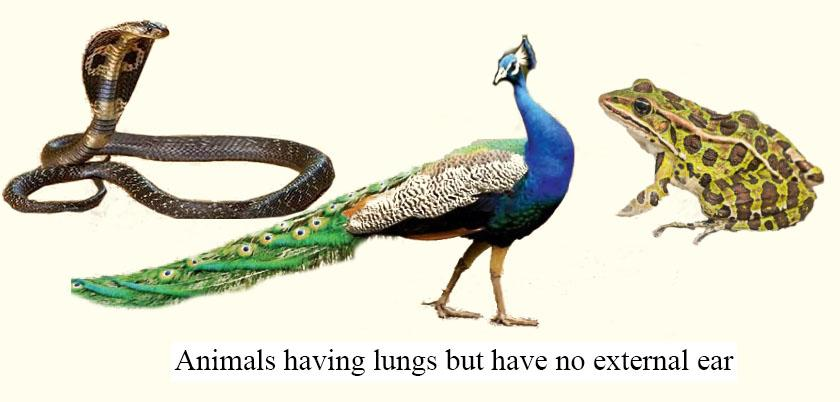
Name three animals (belonging to different classes) which breathe by means of lungs but have no external ears(pinnae).
Answer
473.1k+ views
Hint: The animals which breathe by means of lungs but have no external ears include a reptile that is carnivorous and elongated, a bird that is very beautiful and known for his dance, and an amphibian.
Complete answer:
The three animals (belonging to different classes) which breathe by means of lungs but have no external ears(pinnae) are snakes, frogs, and a peacock. Snake belongs to the class reptilian, frog to class amphibian, and peacock to the class aves.
Additional Information: -The lungs are defined as the organs that are air-filled, and are located on either side of the chest (thorax). The trachea which is also known as the windpipe conducts inhaled air into the lungs through its tubular branches, called bronchi.
The bronchioles will be ending in clusters of microscopic air sacs called alveoli. within the alveoli, oxygen from the air is absorbed into the blood. ${ CO }_{ 2 }$, a waste of metabolism, travels from the blood to the alveoli, where it is often exhaled. Between the alveoli, a thin layer of cells which is known as the interstitium is present which contains blood vessels and cells that help support the alveoli.
-The pinna is known to be the only visible part of the ear (the auricle) with its special helical shape. The pinna acts as a sort of funnel which assists in directing the sound further into the ear.

Note: Even in mammals also some organisms lack ear pinna. Echidna is commonly known as 'spiny anteater', and belongs to the order of egg-laying mammals. They are found in Australia and New Guinea. The external ear, the pinna is absent in them.
Complete answer:
The three animals (belonging to different classes) which breathe by means of lungs but have no external ears(pinnae) are snakes, frogs, and a peacock. Snake belongs to the class reptilian, frog to class amphibian, and peacock to the class aves.
Additional Information: -The lungs are defined as the organs that are air-filled, and are located on either side of the chest (thorax). The trachea which is also known as the windpipe conducts inhaled air into the lungs through its tubular branches, called bronchi.
The bronchioles will be ending in clusters of microscopic air sacs called alveoli. within the alveoli, oxygen from the air is absorbed into the blood. ${ CO }_{ 2 }$, a waste of metabolism, travels from the blood to the alveoli, where it is often exhaled. Between the alveoli, a thin layer of cells which is known as the interstitium is present which contains blood vessels and cells that help support the alveoli.
-The pinna is known to be the only visible part of the ear (the auricle) with its special helical shape. The pinna acts as a sort of funnel which assists in directing the sound further into the ear.

Note: Even in mammals also some organisms lack ear pinna. Echidna is commonly known as 'spiny anteater', and belongs to the order of egg-laying mammals. They are found in Australia and New Guinea. The external ear, the pinna is absent in them.
Recently Updated Pages
The correct geometry and hybridization for XeF4 are class 11 chemistry CBSE

Water softening by Clarks process uses ACalcium bicarbonate class 11 chemistry CBSE

With reference to graphite and diamond which of the class 11 chemistry CBSE

A certain household has consumed 250 units of energy class 11 physics CBSE

The lightest metal known is A beryllium B lithium C class 11 chemistry CBSE

What is the formula mass of the iodine molecule class 11 chemistry CBSE

Trending doubts
Why was the Vernacular Press Act passed by British class 11 social science CBSE

Arrange Water ethanol and phenol in increasing order class 11 chemistry CBSE

Name the nuclear plant located in Uttar Pradesh class 11 social science CBSE

One Metric ton is equal to kg A 10000 B 1000 C 100 class 11 physics CBSE

What steps did the French revolutionaries take to create class 11 social science CBSE

How did silk routes link the world Explain with three class 11 social science CBSE




